
26
HNUE JOURNAL OF SCIENCE
Natural Sciences 2024, Volume 69, Issue 3, pp. 26-34
This paper is available online at http://hnuejs.edu.vn/ns
DOI: 10.18173/2354-1059.2024-0032
THE PREPARATION OF Al-DOPED ZnO THIN FILMS BY SPRAY
PYROLYSIS TECHNIQUE FOR ALCOHOL VAPOR SENSOR
Pham Van Vinh
Faculty of Engineering Physics and Nanotechnology,
VNU University of Engineering and Technology, Hanoi city, Vietnam
*Corresponding author: Pham Van Vinh; e-mail: vinhpv@vnu.edu.vn
Received July 25, 2024. Revised August 22, 2024. Accepted October 30, 2024.
Abstract. Thin films of ZnO and Al-doped ZnO are deposited on glass wafer substrates
using a compressed sprayer system with Zn(CH3COO)2.2H2O and AlCl3 as
precursors. The influence of Al doping concentration on the crystal phase and morphology
of the samples is investigated by XRD and SEM, respectively. The results show that the
films have been crystallized in the form of the wurtzite hexagonal phase of the ZnO
lattice, and the addition of Al does not change the ZnO crystal structure. Despite this,
SEM images show that added Al significantly affects the particle size of the samples.
The particle size decreases and becomes more uniform as the Al concentration
increases up to 7%. Further increasing the Al concentration causes the particles to
agglomerate into clusters. The resistance measurements show that the sheet
resistance of the films decreases in the presence of the Al dopant, providing evidence
that Al has been successfully doped into the ZnO crystal lattice. An appropriate
amount of Al dopant can improve the alcohol vapor sensitivity of the film. The ZnO
film doped with 7% Al exhibits the best alcohol sensitivity.
Keywords: Al-doped ZnO, alcohol vapor sensor, spray pyrolysis.
1. Introduction
Alcohol vapor sensors play a crucial role in various fields due to their ability to detect
and measure the concentration of alcohol in the air. These sensors are pivotal in ensuring
safety, particularly in industries where the presence of alcohol vapors can pose significant
risks. For instance, in the automotive industry, alcohol vapor sensors are essential
components of breathalyzer devices, which law enforcement agencies use to measure
blood alcohol content in drivers [1]-[4]. This application helps prevent drunk driving,
thereby reducing road accidents and enhancing public safety. In the workplace, especially
in environments where the handling of alcohol and other volatile organic compounds is
common, these sensors are vital for maintaining a safe working environment. They
provide early warnings of high alcohol vapor levels, allowing for timely interventions to

The preparation of Al-doped ZnO thin films by spray pyrolysis technique for alcohol vapor sensor
27
prevent potential hazards such as fires or explosions. This is particularly important in
chemical plants, breweries, and laboratories.
Alcohol sensors based on zinc oxide (ZnO) materials have garnered significant
attention due to their high sensitivity, selectivity, and stability [5]-[7]. ZnO is a
semiconductor material known for its excellent electronic properties and high surface-to-
volume ratio, making it an ideal candidate for detecting volatile organic compounds such
as ethanol. The unique properties of ZnO enable it to interact effectively with ethanol
molecules, resulting in measurable changes in electrical resistance that can be accurately
detected and quantified. These properties are further enhanced by doping ZnO with other
elements, which can tailor its sensing properties to specific needs [8]-[11]. Innovations
such as nanostructured ZnO and hybrid materials are expected to further enhance their
sensitivity and selectivity, paving the way for even broader applications [12 ]-[14].
Al-doped ZnO sensors introduce additional benefits through the incorporation of
aluminum atoms into the ZnO lattice. This doping process enhances the conductivity and
electron mobility of the ZnO material [15], leading to improved sensor response times
and greater sensitivity to ethanol at lower concentrations [16]-[18]. The presence of
aluminum also modifies the surface properties of ZnO, increasing its selectivity towards
ethanol while reducing the influence of other gases and potential contaminants [19]. This
heightened selectivity makes Al-doped ZnO sensors especially suitable for environments
with mixed gases, such as industrial settings and environmental monitoring.
Recently, several studies have addressed the alcohol vapor sensitivity of Al-doped
ZnO films. However, these studies have not been truly comprehensive. Most studies have
focused on Al impurity concentrations below 5% [17], [18]-[25] and have investigated
only one alcohol concentration [6], [25] or used a very high alcohol concentration range
(greater than 1000 ppm) [18]. If Al substitutes for Zn, the electrical conductivity of the
film should increase. Unfortunately, there have been no studies on the effect of Al
impurities on the sheet resistance [5], [17], [18], [25], which means the evidence for Al
being successfully doped into the ZnO crystal lattice is not fully convincing. This study
investigates the effect of Al impurity concentrations up to 10% on the alcohol sensitivity
and sheet resistance of the films to develop alcohol vapor sensors.
2. Content
2.1. Experiment
* Deposition method: The thin films of ZnO and Al-doped ZnO are deposited using a
compressed sprayer under computer control. The schematic diagram of the experimental
setup was published elsewhere [20]. The spray solution for pure ZnO is prepared by
dissolving Zn(CH3COO)2..2H2O in C2H5OH at a molarity of 0.2M. After 60 minutes of
stirring, an appropriate amount of HCl is dropped slowly into the solution. The dropping
process finished when the pH of the solution was appropriate at 5 and the solution became
transparent. The dopant solutions are prepared by adding an appropriate amount of AlCl3
to the pure solution. The concentration of Al dopant is calculated based on the amount of
Al in the Zn(CH3COO)2·2H2O and AlCl3 mixture. The solution is then sprayed onto a hot
glass substrate at 400 oC. Due to the thermal decomposition reaction, ZnO and Al-doped
ZnO films are formed.

Pham VV
28
* Characterization methods: The crystal structures are studied using an X-ray
diffractometer (D8 ADVANCE BRUCKER) with Cu Kα radiation (λ = 0.154056 nm).
Surface morphology is observed by SEM (HitachiS-4800). The alcohol sensitivity is
investigated by the static method using a homemade system as shown in Fig. 1. Standard
alcohol vapor with a concentration of 3830 ppm is created by evaporating 100 µl of
alcohol in a 10 l vapor chamber (chamber 1). The sample and sample heater are placed in
a measuring chamber (chamber 2). The sample electrodes are connected to a Keithley
2000 multimeter interfaced with a computer to observe resistance changes.
The resistance measurement over time starts with clean air while the two valves of
chamber 2 are closed. Next, an amount of alcohol vapor taken from chamber 1 is pumped
into the inlet of chamber 2. The concentration of alcohol vapor is determined by the ratio
of the volume of alcohol vapor introduced into chamber 2 to the volume of chamber 2.
After the resistance of the sample drops to a stable value, both valves are opened, and the
pump is used to extract the alcohol-containing gas at the outlet while allowing clean air
to flow into the inlet. The resistance of the sample quickly returns to its original state. The
process is repeated with different alcohol vapor concentrations until the measurement is
completed. The sensor response which is determined as the Ra/Rg ratio (where Ra and Rg
are the resistances of the sensor in the ambiance air and air-gas mixture respectively), is
recorded in the computer as a text file.
Figure 1. Schematic diagram of gas sensor measurement system
2.2. Result and discussion
Figure 2 shows the X-ray diffraction patterns of Al-doped ZnO films deposited with
different Al concentrations at 400oC. Sharp diffraction peaks at 2θ angle positions of
31.81o, 34.46o, 36.29o and 47.58o corresponding to the diffraction planes (100), (002),
(101), and (102) of the Wurtzite hexagonal phase of ZnO lattice (JCPDS data card
No. 36-1451) have been observed. This proves that ZnO has been well crystallized.
No other phases related to Al or other aluminum compounds were found, indicating that the
addition of Al does not change the ZnO crystal structure. Additionally, the intensity of the
diffraction peaks tends to decrease with increasing Al concentration. The reduction in
crystallinity of the Al-doped films may be due to aluminum facilitating the creation of
more nucleation sites, thereby inhibiting the crystallization process [17]. Studies on
Al-doped ZnO films have shown that when Al substitutes for Zn in the ZnO crystal lattice,
the intensity of the diffraction peaks decreases with increasing Al dopant concentration
[21]-[27].

The preparation of Al-doped ZnO thin films by spray pyrolysis technique for alcohol vapor sensor
29
Figure 2. XRD pattern of Al-doped ZnO deposited on substrates
with different Al concentration
Figure 3 shows the change in the sheet resistance of Al-doped ZnO thin films with
different Al dopant concentrations measured at room temperature. The sheet resistance of
the samples tends to decrease with increasing dopant concentration up to 7%. Further
increasing the amount of Al causes the sheet resistance to increase. When an Al atom
(valence III) substitutes for a Zn atom (valence II) in the ZnO crystal lattice, an additional
free electron is created. This is the reason for the decrease in sheet resistance of Al-doped
ZnO films. However, the conduction mechanism of semiconductor thin films is quite
complex. Besides conduction due to the charge carriers in the semiconductor, phenomena
occurring at the grain boundaries also play a very important role. Oxygen adsorbed on
grain boundaries causes a potential barrier that prevents the movement of charged
particles, reducing conductivity (i.e., increasing resistance). Therefore, the sheet
resistance of the semiconductor is always unstable in the presence of air. This is why the
sheet resistance curve is not smooth. This is an inherent property of semiconductor thin
films that is very difficult to control. This is not too serious because small changes in air
resistance do not significantly affect the sensor response results. A large amount of added
Al may create unwanted elements at the grain boundaries because not all Al atoms
substitute for Zn. This will increase the resistance of the film. Despite that, the trend of
decreasing sheet resistance in the thin films is considered indirect evidence that Al has
been successfully doped.
0 2 4 6 8 10
600
700
800
900
1000
1100
1200
Sheet resistance (KΩ/□)
Al concentration (%)
Figure 3. The sheet resistance of the films versus Al dopant concentration
at room temperature

Pham VV
30
Figure 4 shows the SEM images of Al-doped ZnO with different Al concentrations
and the particle size distribution. The particle size tends to decrease and become more
uniform as the Al doping concentration increases. However, when the doping
concentration reaches 10%, the particles aggregate into clusters with a size of about 300 nm.
The particle size distribution calculated from SEM images using ImageJ software shows
that the distribution peaks of the undoped sample are relatively broad, indicating that the
particles are not uniform. Particles with a size of about 120 nm occupy most of the sample
surface area. The distribution peaks gradually narrow when the Al dopant concentration
is increased up to 7%, indicating that added Al makes the particles more uniform.
However, further increasing the amount of Al dopant causes the distribution peaks to
broaden again. The 7% doped sample exhibited the highest uniformity, with the majority
of particles having sizes between 50 nm and 60 nm.
40 80 120 160 200 240 280
0
4
8
12
16
20
24
28
Particle size distribution (%)
Particle size (nm)
a)
40 80 120 160 200 240 280
0
4
8
12
16
20
24
28
Particle size distribution (%)
Particle size (nm)
b)
40 80 120 160 200 240 280
0
4
8
12
16
20
24
28
Particle size distribution (%)
Particle size (nm)
c)
40 80 120 160 200 240 280
0
5
10
15
20
25
30
Particle size distribution (%)
Particle size (nm)
d)
40 80 120 160 200 240 280
0
4
8
12
16
20
24
28
Particle size distribution (%)
Particle size (nm)
e)
Figure 4. SEM images of Al-doped ZnO: a) 0 % Al; b) 3% Al; c) 5%Al;
d) 7%Al; e) 10%Al
Gas sensors typically operate at high temperatures, so the effect of operating
temperature on gas sensitivity is usually investigated before studying other properties of
the sensor. In this study, the effect of temperature on the alcohol vapor sensitivity of Al-
doped ZnO thin films was investigated with an alcohol vapor concentration of 3000 ppm
(Figure 5). The results show that all doped and undoped samples exhibit almost no
response to alcohol vapor at 150 °C. The sensor response increases sharply when the
operating temperature rises above 200 °C. At temperatures exceeding 250 °C, the sensor
response begins to increase slowly and tends to reach a saturation point. These results are
consistent with those reported in previous studies [6], [17], [18]. For sensor applications,
higher operating temperature ranges become less meaningful. Therefore, the temperature of
250 °C was chosen for further studies.




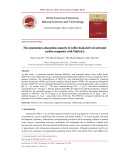
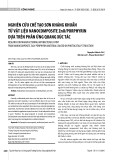
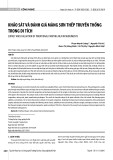
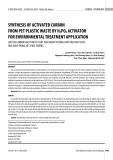
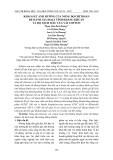

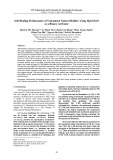
![Bài giảng Vật lý đại cương Chương 4 Học viện Kỹ thuật mật mã [Chuẩn SEO]](https://cdn.tailieu.vn/images/document/thumbnail/2025/20250925/kimphuong1001/135x160/46461758790667.jpg)














